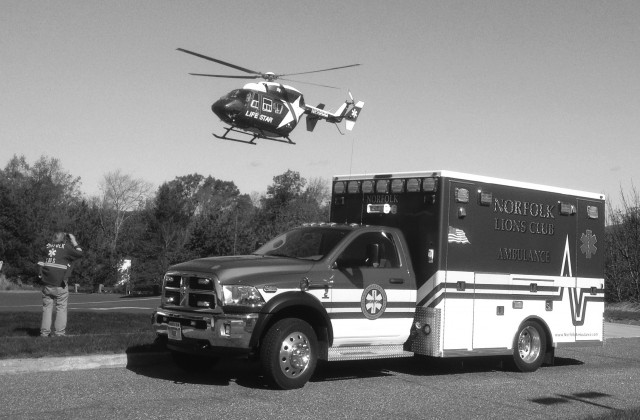On Call With The Norfolk Ambulance
By Christopher Little
Small as Norfolk is, residents in urgent need of help can count on a dedicated response from trained EMTs and drivers, all volunteers of the Norfolk Lions Club Ambulance. The editors have asked Deputy Chief Christopher Little to describe his experiences. Names and details have been changed.
As in police work, an emergency call can momentously shatter hours or even days of inaction. In 2012, we responded to 265 calls. In spite of that number, days may pass without a dispatch, but one night several winters ago we received two critical calls back to back.
At 23:05, our radios, which continuously monitor the ether for the Norfolk-specific pair of musical tones that activate them, went off. “Norfolk Ambulance, respond to 117 Beech Tree Road, Colebrook, the Bonner residence, for a 76-year-old male, possible CVA. 28-Charlie-1.”
The number 28 is the code for stroke, and Charlie-1 means “not alert.” All of which had the duty crew’s undivided attention. A driver and two EMTs responded to headquarters. Knowing the patient, as is often the case in small towns, I decided to respond from home. So did another EMT. Snow was falling and beginning to coat the roads.
The ambulance and I arrived together. Mr. Bonner was lying on his bedroom floor attended to by his distraught wife. Through tears, she stated that he had never suffered a stroke, was healthy for his age, and, most importantly, she had observed his collapse.
After establishing vitals, we applied oxygen and administered the Cincinnati Prehospital Stroke Test—facial droop, arm drift, and abnormal speech. A score of three indicates that the probability of an acute stroke is more than 85 percent. Unfortunately, Mr. Bonner earned a three.
Knowing when he had been neurologically intact was key, because it prompted us to issue a “stroke alert” to the hospital, but it also meant that time was of the essence. While one of the EMTs comforted Mrs. Bonner, the rest of us transferred our patient to the gurney.
It was at that moment when Norfolk’s tones went off again: “Norfolk Ambulance first responders and North Canaan, under mutual aid, respond to 22 Wheeling Road, the McLane residence, for a 78-year-old female, cardiac arrest. Patient is unresponsive, not breathing. 9-Echo-1.”
Two of us left Mrs. Bonner in the steady hands of the duty crew and headed for North Norfolk. Another off-duty EMT signed on. At least two inches of snow had fallen. My truck slalomed on the unplowed roads. For sure, an Echo call gets the adrenaline pumping. We know that the efficacy of a defibrillator drops 10 percent each minute the patient is in arrest. However frustrating, I had to slow down if we were to get there at all.
When we finally arrived, we raced upstairs with a defibrillator, airways, oxygen, and a bag valve mask for squeezing oxygen into a non-breathing patient. The off-duty EMT, who had arrived first, wasn’t strong enough to drag her off her bed alone. Mrs. McLane’s husband was too frail to help. However brutal it sounds, you cannot do effective CPR on a squishy surface. We pulled her onto the floor.
Mrs. McLane was pulseless and apneic; her pupils were fixed and dilated. I had a very bad feeling. No one had witnessed her arrest. Worse, her skin was room temperature. I interlocked my fingers and with the heel of my hand gave her a series of hard, fast sternal compressions. At the same time, my colleague attached the defibrillator while the third “bagged” her.
We stopped CPR to let the defib analyze her heart rhythm. Its disembodied voice advised “No shock.” No shock can be good news—meaning her heart has a non-shockable rhythm—but, in this case, it was very bad news. Per protocol, we worked on her all the way to Torrington.
Mr. Bonner recovered fully. Mrs. McLane was pronounced at the hospital.
The what-ifs begin to crop up on the drive home. What if it hadn’t been snowing? What if her husband had found Mrs. McLane sooner? How could we have done better?
Such thoughts persist.
PHOTO BY CHRIS PETERSON

